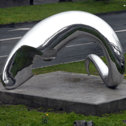Tony Cragg
Robert Elfgen
Harald Klingelholler
Cornelia Parker
Ina Weber
Ulrike Groos
Peter Gorschlueter
24/4/2007
Five Viewpoints Wuppertal
Five sites, Wuppertal
Group show

Group show
Curated by: Ulrike Groos and Peter Gorschlueter
Public Art Projects in the City of Wuppertal
Five internationally celebrated artists – Tony Cragg, Robert Elfgen, Harald Klingelhöller, Cornelia Parker and Ina Weber – have been invited to explore the topographical and architectural situation, as well as the social climate, of Wuppertal and to respond to what they discover with site-specific public art projects. Until 23 September these works will provide a commentary upon the urban space of Wuppertal and offer unusual and surprising views on this unique city situated on the river Wupper. The selected positions comprise a wide range of artistic strategies: sculpture, social interaction, surveys of the urban space and the city's history as well as installations interacting with their specific surroundings. What links all five artists is their view of the city, be it from the point of view of long-time residents, therefore very intimate and in-depth – Tony Cragg and Harald Klingelhöller –, or as outsiders, namely Robert Elfgen, Cornelia Parker and Ina Weber.
The bronze sculpture of well-known Wuppertal artist Tony Cragg comprises an amorphous structure with two columns formed by geometrical shapes – ellipses and tripods – projecting 6.5 metres into the air. Its weave-like structure is reminiscent of textile threads and thus of the history of Wuppertal as an important city in the 19th century textile industry.
The instance of the shared experience of, as well as the playful approach to art, is a substantial component of Cologne artist Robert Elfgen's project for Wuppertal. As an autonomous, navigable sculpture and stage for a variety of actions, Elfgen's Castle stands proud like a trademark on the Berliner Platz.
Harald Klingelhöller's sculpture for Wuppertal places the words "WHY" and "POP" into interesting, multifaceted relationships, both formally as well as in terms of content: they can be perceived individually, read as a question, or as a game of question and answer. Since the founding of Bayer's "Farbenhandlung" (dyestuff factory) in 1863 the river Wupper repeatedly changed colour due to the effluent pumped into it from the textiles factories nearby. With reference to this Cornelia Parker has "coloured" the views for passengers on the suspension monorail by allotting individual colours and idioms in which they appear to particular trains.
Berlin artist Ina Weber replaces the bus shelter at the Stop "Kluse / Schauspielhaus" in Wuppertal with one of her own designs. Her multicoloured intervention ironically glorifies and questions the bus stop as a location of perpetual waiting as well as a meeting place for young people.
The art project forms a part of the Open Space Programme for the Wuppertal valley of the "Regionale 2006", a project initiated by the Cultural Administration of The City of Wuppertal.
The project is part of the "Bergische Expo '06".



